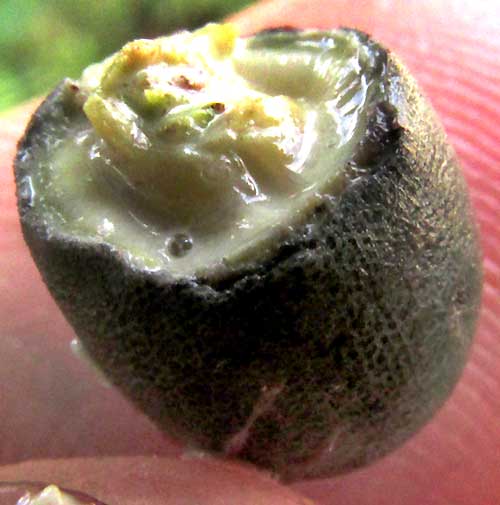Excerpts from Jim Conrad's
Naturalist Newsletter
from the March 8, 2019 Newsletter with notes from an October, 2018 camping trip to Chiapas, the southernmost state of MÉXICO
FRUITING TROPICAL MISTLETOE

Last October 5th, beside the entry road to Palenque National Park in Chiapas, Mexico's southernmost state, a bushy cluster of mistletoe grew so low in a tree that I could touch it. It was obviously a mistletoe because it bore fleshy, green leaves, and issued roots into a tree limb's wood. However, recognizing something as a member of the Mistletoe Family, the Loranthaceae, is just the beginning, because several kinds exist. In the Yucatan Peninsula north of Chiapas, ten species in four genera are listed, and Chiapas, being rainier and having a more diverse topography, probably harbors more. Our Palenque mistletoe was fruiting, as seen above.
In that picture note that the fruit clusters arise from leaf axils, not at the tips of branches. That feature alone disqualifies one of the four genera, but it's a commonly occurring one. Also notice that the leaves are fairly large and almost round. A close-up of some maturing fruits on their unusually thick, woody stems is shown below:

Notice that the green stem is sharply angled in cross section. The fruits, when a top is bitten off, reveal a solitary seed inside, and the injured flesh bleeds copious milky latex, as seen below:

By comparing these features with online images of all the mistletoe species listed for Chiapas, this species reveals itself as STRUTHANTHUS ORBICULARIS, occurring from southern Mexico south through Central America, well into South America.
In some places English speakers have taken to calling Struthanthus orbicularis the God Bush or God Almighty Bush, and one wonders why. It's true that it's used variously in traditional medicine, though its cures are of the common sort. In Messages from the Gods: A Guide to the Useful Plants of Belize, by Michael Balick and Rosita Arvigo -- partly available online at Google Books -- it's reported to cure headaches and to lower blood pressure.
The Maya often regard two similar plant species to be the males and females of just one species, the female normally being smaller than the male. Balick and Arvigo report that the Maya in Belize regard our Struthanthus orbicularis with its fairly large leaves and long-dangling stems as the male of a species in which the female is Psittacanthus mayanus, which we profile at www.backyardnature.net/yucatan/psittaca.htm
That "female" species produces a more compact but smaller bush than our "male" Struthanthus orbicularis, though its red flowers are much more eye-catching than the greenish or greenish-yellow flowers of our "male," which are only about 7mm long (¼in). This pairing sort of makes sense if you're into sexual stereotypes.